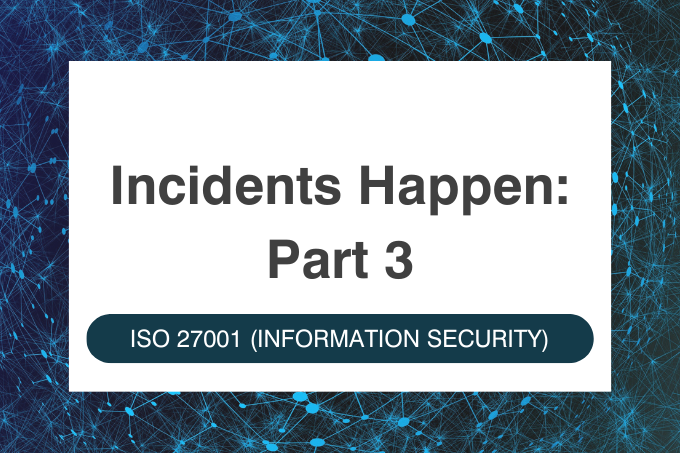Incidents Happen: Objectives, measurements and planning (part 3 of 3)
Information security incidents can be inevitable. Take every setback as an opportunity for improvement, with NQA Regional Assessor Michael Harper guiding you there.

DISCLAIMER
This series (and the following scenario) is a shortened and simplified account of incidents and incident response. It is not intended to be an exhaustive list of everything to complete. As every incident and organisation are different, your approach should be risk-based and fit your organisation.

Welcome back to ‘Incidents Happen’: a 3-part blog series brought to you by NQA.
While this series focuses on information security, the principles apply to any context. A machine tool not behaving as expected, a release of waste, an accident at work… incidents like these can occur anywhere and at any time.
In Part 3 of the series, we cover:
-
The difference between objectives and measurements.
-
An effective way to lay out the stages of implementation.
-
Our real-life incident scenario from Part 2 (here) in practice.
![]() This is the final part of our ‘Incidents Happen’ series. Enjoy!
This is the final part of our ‘Incidents Happen’ series. Enjoy!
![]() Need to catchup first? Read Part 1 (the basics) and Part 2 (the scenario).
Need to catchup first? Read Part 1 (the basics) and Part 2 (the scenario).

The difference between objectives vs. measurements
When it comes to objectives and measurements, you can think of them this way:
-
Objective = a specific goal for the benefit of the business.
-
Measurement = assessing the effectiveness of the implemented objective.

Recap: a real-life incident scenario
NQA recommends creating a programme to outline each stage of objective implementation.
Let’s use the real-life incident scenario from Part 2*:
A salesman (Henry) was caught emailing himself confidential information to take to his new employer. Decision-makers at his current company (Speed29) wanted to reduce the risk of something similar happening again. They set a new objective to select, install and configure a suitable data loss prevention tool by the end of 2023.
*The examples, business names and incidents portrayed in this article are fictitious. No identification with actual businesses, products or services is intended or should be inferred.

The best-practice method of objective implementation
PHASE 1: Expand on the objective
All ISO standards are fairly similar when it comes to objectives.
According to Clause 6.2 of ISO 27001 (Information Security Management Systems) and other ISO standards, objectives must be:
Aligned with the relevant policy
-
The data loss prevention tool will enhance information security and demonstrate continual improvement.
Measurable (if possible)
-
The organisation will have either completed the objective or not, with progress points included in the programme.
Relevant
-
An incident has occurred; the data loss prevention tool will be introduced to reduce the risk of it happening again.
Communicated
-
The incident, risk and objective have been documented. They are also agenda items on the management review.
Updated
-
The data loss prevention tool plan is a dynamic working document that’s reviewed and updated regularly.
![]() The SMART (Specific, Measurable, Achievable, Relevant and Time-Bound) method can help.
The SMART (Specific, Measurable, Achievable, Relevant and Time-Bound) method can help.

PHASE 2: Write the plan
Objective: Select, install and configure a suitable data loss prevention tool by the end of 2023.
Step 1: Identify suitable products
-
Resources: Websites, trade shows and time
-
Responsible: Information Security Manager (ISM) and Chief Technology Officer (CTO)
-
When: End of June 2023
-
Evaluation: ISM and CTO to compare different vendors
Step 2: Watch vendor demonstrations
-
Resources: CTO, ISM, IT team members, time and rooms
-
Responsible: ISM
-
When: End of July 2023
-
Evaluation: Team members agree on suitable vendors to obtain quotes from
Step 3: Obtain quotes from suitable vendors
-
Resources: Time
-
Responsible: ISM
-
When: End of August 2023
-
Evaluation: ISM receives the quotes
Step 4: Select the vendor
-
Resources: Time
-
Responsible: CFO (Chief Financial Officer), CTO and ISM
-
When: End of September 2023
-
Evaluation: A vendor has been selected based on price, value and functionality
Step 5: Install the data loss prevention tool software
-
Also, remember to consider:
-
Change control
-
Privacy impact assessments
-
Security impact of any system
-
Updating risk assessments
-

PHASE 3: Check if the tool works
Monitoring is referred to in Clause 9.1 of ISO standards.
Under Clause 9.1, decision-makers within an organisation must choose what, how and when they will monitor. They also confirm who will conduct the monitoring – and who will analyse the results.
In the context of our real-life incident scenario, this could be:
What (KPI)
-
False positive alerts to be less than 5% of the total alerts.
-
False positive = when a scanning tool incorrectly flags a security vulnerability (i.e. there is no bug, or functionality is actually working).
-
How (method)
-
Reports from the data loss protection tool.
When
-
Reports shall be obtained monthly.
Who
-
IT Support will run the reports as part of their monthly monitoring and reporting tasks.
Results analysis
-
The ISM will receive and review the reports each month, with the results tracked and presented at management review.

Final thoughts from NQA
There you have it: a simplified breakdown of incidents, from setting an objective to creating a programme.
Thank you for taking part in our ‘Incidents Happen’ series. While we have focused on information security, the principles apply to any organisation – no matter the context.
![]() Want a recap? Visit Part 1 (the basics) or Part 2 (a real-life scenario) of the series.
Want a recap? Visit Part 1 (the basics) or Part 2 (a real-life scenario) of the series.
![]() If your organisation needs advice on Information Security, arrange a call-back today.
If your organisation needs advice on Information Security, arrange a call-back today.
Get your business up to speed with ISO 27001 (Information Management)
Sign up for our mailing list to receive the latest on ISO 27001 – plus industry updates, expert content and more 👇
